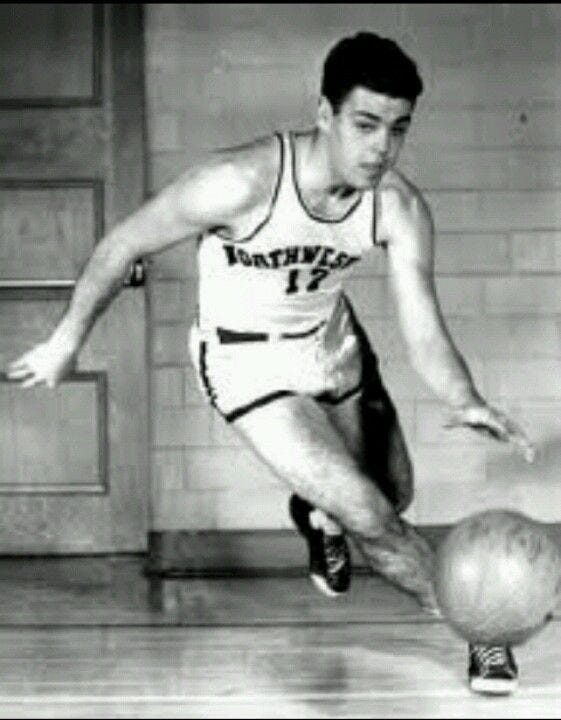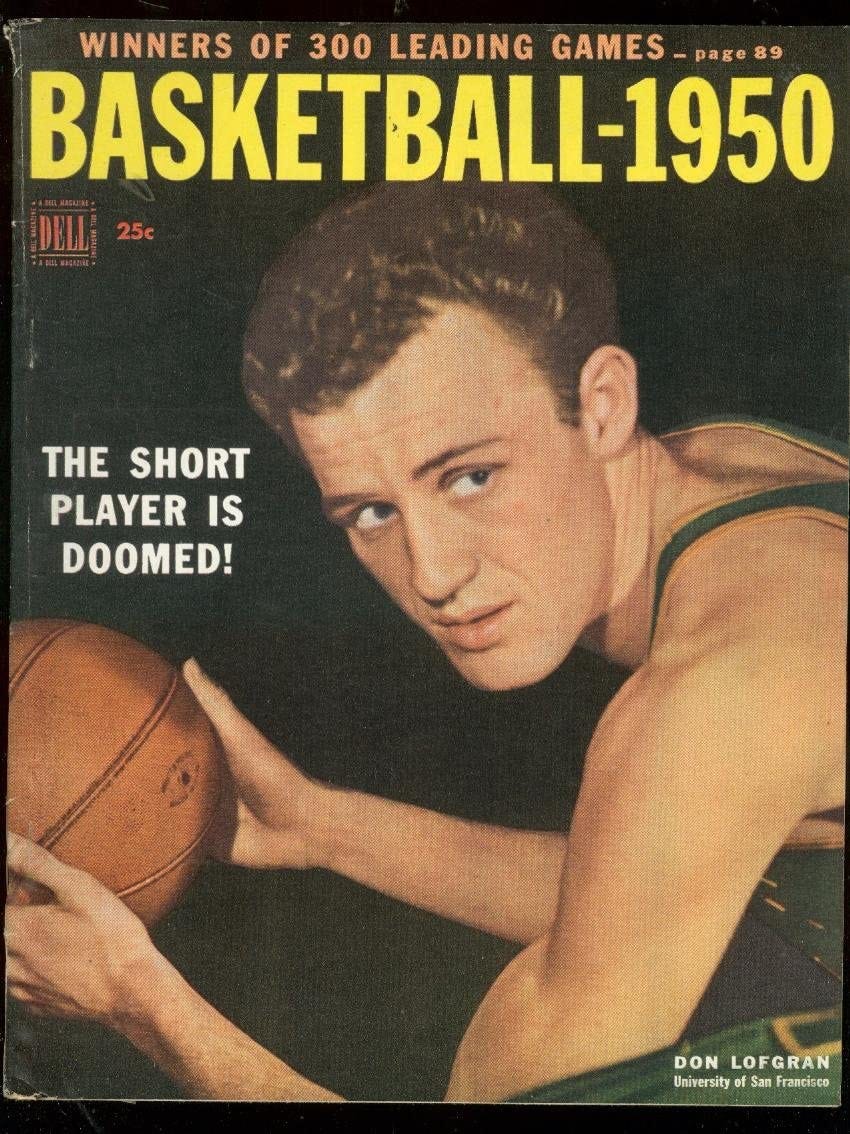College Basketball All-Decade Teams: The 1940s
George Mikan, Paul Arizin and Bob Cousy transformed pro basketball in the 1950s, thanks in part to their college stardom in the '40s.
Press Break presents its All-Decade Teams from the 1940s through the 2010s. Teams were determined through a combination of individual accolades, statistics, team accomplishments, historic impact on the game and — in some cases, admittedly — my own subjectivity.
Players who appeared in two decade are placed based on when their final season occurred. To wit, a 1949-50 senior counts for the 1940s; a 1950-51 senior counts toward the 1950s. Each decade includes five teams with five players each, in part to include a more robust snapshot of every 10-year span, and in recognition of college basketball’s association with Top 25s.
Beginning this exercise in the 1940s might seem arbitrary, given college basketball had grown exponentially during the Great Depression and could be fairly deemed a mainstream sport in the 1930s. To wit, the first NCAA Tournament was held in 1939; the National Invitational Tournament capitalized on the booming popularity of the game in New York with its first installment a year earlier.
Finding reliable records for the 1930s, including All-American teams as diversified as they were in the 1940s, was much more difficult. Further, the 1940s proved more integral in shaping the sport’s future with the emergence of true stars, particularly in the latter-half of the decade after the end of World War II and the populace having more money for leisure time.
Some of the below placements are obvious; others were more difficult. One element difficult to navigate was the homogeny of the sport. College basketball was integrated well before the pro leagues that eventually merged and formed the NBA, starting with three Black college stars included below.
Still, the sport was heavily segregated and a few years away from Bill Russell at San Francisco and Wilt Chamberlain at Kansas beginning to usher in mainstream Black stardom. Someone in the 1940s like Marques Haynes was integral to reinventing the sport, despite playing at the NAIA level. For that reason, I did not adhere exclusively to what we know today as NCAA Div. I.
So as not to overload your inboxes, I have limited explanatory capsules to the five 1st Team nominees and select players on the 2nd-through-5th. Feel free to add your debate, suggestions or objections in the comments.
FIRST TEAM
C - George Mikan, DePaul
George Mikan emerging as professional basketball’s first superstar is owed in part to him joining the league already boasting a high profile. College ball was considerably more popular than pro in this era, and Mikan built considerable interest as a three-time All-American and NIT Most Valuable Player at DePaul.
F - Paul Arizin, Villanova
College basketball’s explosion in popularity post-World War II was due in part to the game’s evolution. In the early 1940s, All-Americans were scoring in the mid-teens or below. By the end of the decade, electric scorers like Paul Arizin emerged and began the first shift to the modern game.
Arizin averaged 22 points per game as a junior, and 25.3 per in his senior season when he earned 1st Team All-American recognition.
F - Ed Macauley, Saint Louis
Until the game-fixing revelations of the early ‘50s, the NIT overshadowed the NCAA Tournament as college basketball’s premier postseason event. Ed Macauley became a hoop legend with his play at Madison Square Garden in 1948, when he capped the first of two 1st Team All-American seasons winning NIT MVP.
G - Bob Cousy, Holy Cross
Michael Jordan isn’t necessarily the first comparison that might spring to mind when thinking of Bob Cousy. However, both can accurately be credited with transforming the way people saw how the game could be played.
His uncanny ball-handling and passing was well ahead of its time, much in the same way Jordan’s high-flying and slashing transcended the style generations later. Both also broke onto the scene as integral cogs in a national championship as freshmen.
Winning the title his first year at Holy Cross set Cousy on course for a stellar college career with three All-American nominations.
G - Ralph Beard, Kentucky
I’ll preface the following by acknowledging I have no love for Adolph Rupp. Even in an era of strict segregationist attitudes, Rupp was particularly brazen (and remained that way well after basketball, and society, evolved). The excellent book The City Game offers further insight into Rupp’s arrogance extending beyond a reflection of an unfortunately prevalent racism of the bygone era.
That said, it’s impossible to deny that Rupp built college basketball’s original dynasty in the 1940s into the early 1950s. Ralph Beard was at the forefront (though arguably not the Wildcats best player — more on that below). Beard was a three-time All-American and driving engine for two national championship-winning teams.
SECOND TEAM
C - Bob Kurland, Oklahoma A&M
Arguably the second-most impactful player of the decade, Bob Kurland dominated the paint while leading what’s now Oklahoma State to back-to-back national championships. Kurland scored 65 points in three NCAA Tournament games in 1945, and followed it up with 72 the next year.
Kurland earned consensus 1st Team All-American honors three times, rivaling Mikan as the nation’s most prominent and dominant player in the mid-1940s.
F - Paul Unruh, Bradley
F - Dick Schnittker, Ohio State
G - Sid Tanenbaum, NYU
Two-time All-American Sid Tanenbaum’s national recognition coincided with his earning a pair of Haggerty Awards. The Haggerty honored the best player in metropolitan — and considering NYC was the center of the basketball universe at the time, that’s no small feat.
Although NYU also produced Dolph Schayes, one of the most influential players in the early years of the NBA, Tanenbaum was arguably the better college player from all accounts.
G - Andy Phillip, Illinois
A three-time All-American whose nominations actually span two eras, Andy Phillip was a standout both before and after World War II. He interrupted his standout career to serve, then returned without missing a beat.
THIRD TEAM
C - Alex Groza, Kentucky
As noted above, Ralph Beard may be on my 1st Team, but he was arguably not the star of Kentucky’s late ‘40s dynasty: That was Alex Groza.
The three-time All-American Groza elevated his play to another in 1949 in particular, scoring more than 20 points per game.
F - Chuck Cooper, West Virginia State/Duquesne
Chuck Cooper ranks among the most fascinating figures in basketball history. One of the players responsible for breaking professional basketball’s race barrier, he started at HBCU West Virginia State, which also produced another of the NBA’s Black pioneers, Earl Lloyd.
Cooper left West Virginia State to serve in World War II, however, and returned to finish his career as a two-time All-American at Duquesne in his native Pittsburgh.
F - Charles B. Black, Kansas
G - Bill Sharman, USC
G - Marques Haynes, Langston
Marques Haynes was perhaps as important for revolutionizing point-guard play as Bob Cousy, though the less prominent stage and far less extensive coverage of his exploits obfuscates Haynes’ influence. He may not have had the chance to shine at the NIT or NCAA Tournament, having played at tiny Langston University in Oklahoma, but Haynes became a bona fide star with the Harlem Globetrotters.
Before running the show as the Globetrotters point guard, including in a win over the reigning NBA champion Minneapolis Lakers in 1948, Haynes actually captained Langston to a win over the Trotters two years prior. The victory was part of an astounding 112-3 record the school compiled during Haynes’ time there.
FOURTH TEAM
C - George Glamack, North Carolina
F - Earl Lloyd, West Virginia State
Earl Lloyd joined Chuck Cooper and “Sweetwater” Clifton in integrating the NBA. Before his trailblazing pro transition, Lloyd won two Central Intercollegiate Athletic Association championships, was a three-time All-CIAA selection, and a two-time All-American.
F - Leo Klier, Notre Dame
G - Gus Broberg, Dartmouth
One of the most decorated players of the decade, Gus Broberg earned three All-American honors and was named the Helms National Player of the Year as a sophomore in 1939.
While basketball did not speed up until after the War, comparatively speak, Broberg was a standout scorer who routinely hit for more than 20 points in his time with the since-renamed Indians.
G - Dick McGuire, Dartmouth/St. John’s
FIFTH TEAM
C - Harry Boykoff, St. John’s
F - Otto Graham, Northwestern
Otto Graham — yes, THAT Otto Graham — won All-American basketball recognition twice before becoming a pro-football legend.
F - Don Lofgran, San Francisco
In perhaps the same way that Armen Gillam was the prototype for Larry Johnson at UNLV in the Tark years, Don Lofgran’s dominant play in the middle helped lay the foundation for University of San Francisco successor Bill Russell.
Lofgran was a two-time All-American, and in 1949, won MVP of the NIT.
G - Arnie Ferrin, Utah
G - Johnny Adams, Arkansas
Earlier this spring, I finished reading a great book by historian John Christgau, The Origins of the Jump Shot. Christgau chronicles the backstories of several luminaries who introduced the game-changing jumper to basketball, including collegiate standouts: ski-jumper turned hooper Myer “Whitey” Skoog (Minnesota), early-NBA scoring machine Joe Fulks (Murray State), and NCAA Tournament star Kenny Sailors (Wyoming).
Another profile in Christgau’s book is that of “Jumpin’” Johnny Adams, whose nickname belied the fact that observers joked you could slip a sheet of paper between the hardwood and his feet when he elevated for his shot.
Despite the limitations of his vertical, Johnny Adams’ rudimentary version of the jumper at the beginning of the 1940s nearly won Arkansas a national championship and earned Adams extensive media coverage at a time when programs west of about Pennsylvania failed to gain much attention.





